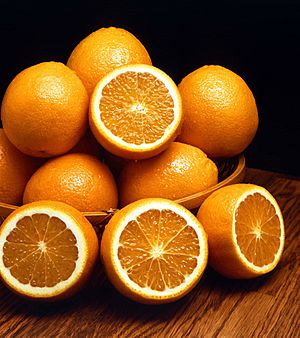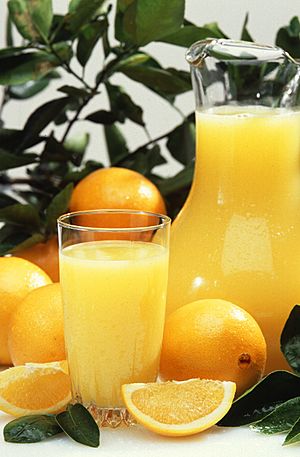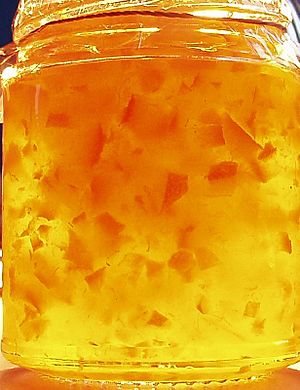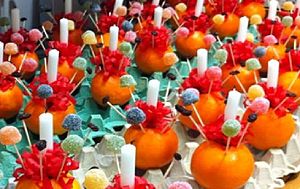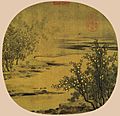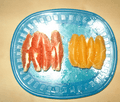Orange (fruit) facts for kids
Quick facts for kids Orange |
|
|---|---|
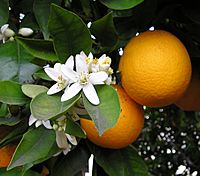 |
|
| Orange blossoms and oranges | |
| Scientific classification | |
| Kingdom: | |
| Division: | |
| Class: | |
| Order: | |
| Family: | |
| Genus: | |
| Binomial name | |
| Citrus sinensis (L.)
|
|
An orange is a type of citrus fruit that many people enjoy eating. Oranges are packed with vitamin C, which is super important for your body! Many people start their day with a glass of orange juice for breakfast. The "sweet orange," which is the most common type today, first grew in Asia. Now, you can find oranges growing in many places around the world.
Oranges are round and, of course, orange! They grow on a tree that can get as tall as 10 meters (about 33 feet). Orange trees have dark green, shiny leaves and small, white flowers with five petals. These flowers smell really sweet, which helps attract lots of bees.
An orange has a tough, shiny orange skin. Inside, the fruit is split into "segments." These segments have thin skins that hold together many tiny sections filled with juice. Most oranges have about ten segments, but some might have more. Inside each segment, you'll often find seeds, called "pips." You can grow orange trees from these pips. However, some types of orange trees can only be grown from "cuttings." A cutting is a piece cut from a tree that is made to grow new roots.
The segments and the outer skin are separated by a white, stringy material called "pith." With most oranges, you can easily peel the skin away from the pith. Then, you can pull the segments apart with your fingers to eat them. Some oranges are a bit harder to peel. But mandarin oranges are super easy to peel! Their skin, pith, and segments all come apart very easily. The skin of an orange is often called "orange peel."
Oranges are a really important food source worldwide. This is for a few reasons. They are a common and easy way to get vitamin C. They also last longer than many other fruits when stored. Plus, they are easy to transport because their tough skin acts like a natural container. You can pile them up or carry them in bags without them getting easily damaged.
The color orange got its name from the fruit! The word "orange" is quite special in the English language. It's one of the few English words that doesn't rhyme with anything.
Contents
History of Oranges
Where Oranges Came From
Sweet orange trees first arrived in Italy, Spain, and Portugal from India in the 1400s. Before that time, only sour oranges were grown in Italy. From Europe, orange trees were taken to the United States, South America, Africa, and Australia. These places now grow many oranges to sell.
Types of Sweet Oranges
There are several different kinds of sweet oranges. One very common type is called the "Valencia" orange. It comes from Spain and is also grown in Africa and Australia. It's an important "commercial" orange, meaning it's grown a lot to be sold in stores.
Another type of sweet orange is the "blood orange," sometimes called "sanguine orange." "Sanguine" means blood red. These oranges often have red marks on their skin. Some parts of the inside look like they have blood in them. The juice from some blood oranges can be a deep ruby red color.
In the 1850s, in Brazil, a special tree grew in a monastery garden. This tree produced very unusual fruit. Inside each orange skin, there was a large orange with no seeds. At the bottom of this orange was a tiny "baby orange." This baby orange made a strange bump at the bottom of the main orange's skin. It looked just like a human "belly-button". Because of this, these oranges were named "Navel Oranges."
Navel oranges tasted very sweet, had no seeds, and were quite easy to peel. This made them excellent for growing and selling "commercially". However, they couldn't be grown from seeds. They could only grow from cuttings. Today, thousands of navel orange trees have been planted from these cuttings. "Navel Oranges" are grown in California and sent to many countries worldwide. Every navel orange you eat has the exact same genetic makeup as the oranges from that original tree in Brazil!
Mandarins and Their Varieties
Mandarins are small, slightly flattened oranges with skins that come off very easily. People believe they first came from China. Now, there are several different types of mandarins. These include "tangerines," which are redder than most mandarins, and "clementines," which are larger, smooth, and plump. Mandarins are great for lunchboxes because they are easy to peel and eat. They also don't get squashed easily.
Today, many people around the world eat an orange or drink orange juice every day. This is because oranges are one of the best and cheapest ways to get Vitamin C. Unlike many other animals, human bodies don't make Vitamin C on their own. So, we need to get it regularly from our food. Vitamin C helps your body grow, heal wounds, and fight off infections. Oranges are also a very good source of dietary fiber. However, they don't have a lot of minerals. If you eat an orange and a banana together, you'll have a very healthy snack that gives you both vitamins and minerals! Oranges are naturally sweet and juicy.
Orange Juice and Other Products
Oranges can taste anywhere from sweet to sour. People usually peel them and eat them fresh, or they squeeze them to make juice. The thick, bitter rind (outer skin) is usually thrown away. But it can be processed into animal feed. It's also used in some recipes for flavor or as a garnish. The very outer layer of the rind can be grated thinly with a zester to make orange zest. Zest is popular in cooking because it has oils and a strong flavor, similar to the orange fruit itself. The white part of the rind, including the pith, is a source of pectin. It also has almost as much vitamin C as the orange flesh, plus other good nutrients.
Even though it's not as juicy or tasty as the inside, orange peel is edible. It has a lot of vitamin C, dietary fiber, and other helpful things like potassium and magnesium.
What Can Be Made from Oranges?
- Orange juice is made by squeezing the fruit with a special tool called a juicer or squeezer. You can make it at home, or it can be made on a much larger scale in factories. Brazil makes the most orange juice in the world, followed by the United States.
- Frozen orange juice concentrate is made from fresh, squeezed, and filtered orange juice.
- Sweet orange oil is a by-product of making orange juice. It's made by pressing the orange peel. This oil is used to add flavor to food and drinks. It's also used in perfumes and aromatherapy because of its nice smell. Sweet orange oil is mostly made of something called D-limonene. This is a solvent used in many household cleaners, like wood polish and detergents. It's a good cleaning agent with a pleasant smell.
- Marmalade is a type of fruit preserve. It's traditionally made with Seville oranges, which are less sweet. All parts of the fruit are used. The pith and seeds are boiled with the juice, peel, and sugar. This helps to get out the pectin, which makes the marmalade set.
- Orange peel can even be used by gardeners to keep slugs away!
Orange Traditions and Symbols
- Orange trees are a symbol of love and marriage in many cultures. You can sometimes see oranges in old paintings of married couples. One famous example is Jan van Eyck's "Wedding Portrait of the Arnolfini."
- Brides traditionally wear orange blossoms in their hair or carry them in their wedding flowers. Orange blossoms are also often used to decorate wedding cakes.
- Queen Victoria received a special crown made of gold and enamel orange blossoms from her husband, Albert. When their children were born, he had a jeweler add tiny green oranges to the crown.
- If you peel an orange carefully with a knife, you can sometimes get the peel off in one long, unbroken piece. In some countries, schoolgirls would chant a rhyme and throw the long orange peel over their shoulder. They would then look at how it landed to find the initial letter of the name of the boy who loved them.
- In some European countries, a "Christingle" is a Christmas decoration. It uses an orange and a candle to symbolize Jesus' love for the world.
- In cold countries, when fresh fruit was hard to find, an orange was often given as a special gift at Christmas. In England, it was traditional to put raisins, almonds, and oranges in the toe of a child's Christmas stocking.
- Orange peel can be dried and treated with sugar. It's an ingredient often used in Christmas cakes.
- Oranges are sometimes used to make a sweet-smelling "pomander" to make a room smell nice. To do this, you stick the stalks of cloves into an orange and let the orange dry out.
- Orange jam is called "Marmalade." There are old stories that say it was first made for Mary, Queen of Scots or Marie Antoinette when they were sick. However, these stories aren't true. Marmalade was made in Portugal many years before either of them were born. The word "marmalade" originally meant a quince jam ("marmelada" in Portuguese). It comes from the Portuguese word for quince, "marmelo."
- An old English children's song about the church bells of London starts with the line: "'Oranges and Lemons' say the Bells of St. Clements..."
Other Pages to Explore
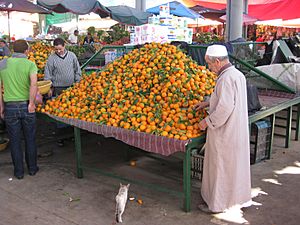
Images for kids
-
Yellow Oranges and Green Tangerines by Zhao Lingrang, a Chinese fan painting from the Song dynasty (NPM)
-
An orange vendor in Ilorin, Kwara, peeling an orange
-
An orange grove in Florida
-
An orange tree covered and damaged by snow, in the Netherlands
-
An orange grove in California
See also
 In Spanish: Naranja (fruta) para niños
In Spanish: Naranja (fruta) para niños


